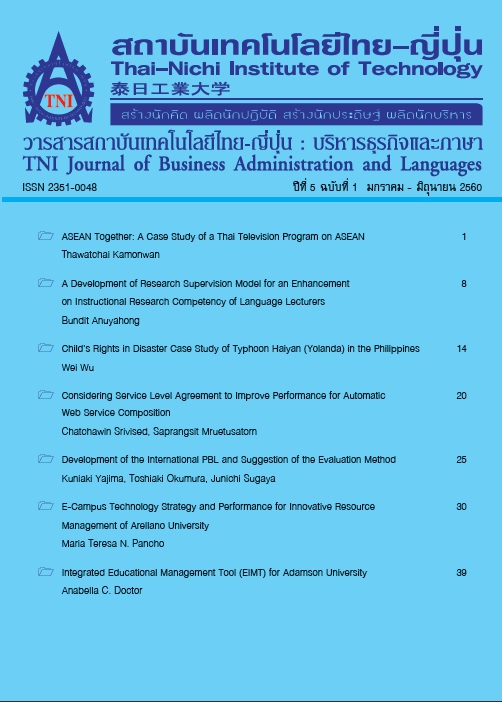E-Campus Technology Strategy and Performance for Innovative Resource Management of Arellano University
Main Article Content
Abstract
The study determined the relationship of e-campus technology strategy such as process automation, cloud computing, on-line promotion, and greening information technology and e-campus technology performance of Arellano University (AU). The paper studies the role of technology applications and a university’s technology strategy on the effectiveness and efficiency of e-campus technology. Moreover, the research output is to propose e-campus technology for innovative resource management based on the analysis of e-campus technology strategy and performance of AU. The concept involves management of organizational resources for effective and efficient e-campus technology performance. The study used descriptive research design and employed the five (5) branches of AU as respondents. The groups of respondents consist of graduating IT students, IT professors, and IT staff with 161 sample size of the study. The research used descriptive statistics in analyzing e-campus technology strategy and performance. Moreover, inferential statistics such as t-test was used to determine significant relationship between e-campus technology strategy and performance. The result reveals that process automation strategy is statistically significant to e-campus performance and other strategies are not. Thus, it is apt to recommend the proposed e-campus technology for innovative resource management of AU to acquire, develop, maintain, and utilize e-campus strategy for effective and efficient e-campus technology performance.
Article Details
Article Accepting Policy
The editorial board of Thai-Nichi Institute of Technology is pleased to receive articles from lecturers and experts in the fields of business administration, languages, engineering and technology written in Thai or English. The academic work submitted for publication must not be published in any other publication before and must not be under consideration of other journal submissions. Therefore, those interested in participating in the dissemination of work and knowledge can submit their article to the editorial board for further submission to the screening committee to consider publishing in the journal. The articles that can be published include solely research articles. Interested persons can prepare their articles by reviewing recommendations for article authors.
Copyright infringement is solely the responsibility of the author(s) of the article. Articles that have been published must be screened and reviewed for quality from qualified experts approved by the editorial board.
The text that appears within each article published in this research journal is a personal opinion of each author, nothing related to Thai-Nichi Institute of Technology, and other faculty members in the institution in any way. Responsibilities and accuracy for the content of each article are owned by each author. If there is any mistake, each author will be responsible for his/her own article(s).
The editorial board reserves the right not to bring any content, views or comments of articles in the Journal of Thai-Nichi Institute of Technology to publish before receiving permission from the authorized author(s) in writing. The published work is the copyright of the Journal of Thai-Nichi Institute of Technology.
References
[ 2] Asgarkhani M .“The Effectiveness of e-Service in Local Government: A Case Study” The Electronic Journal of e-Government ,Volume 3, Issue 4, pp 157-166, 2005.
[ 3] Alvarez, L. R., & Barone, “C. A. Why Technology?,” Educom Review, 31(3),25., 1996.
Burgelman, R., and Doz, Y.. "The power of strategic integration, Sloan Management Review, Volume 42, Number 3, 2001.
[ 5] Smith, H.A., Mckeen, J.D., & Singh. S., “Developing Information Technology Strategy for Business Value,” Journal of Information Technology Management, Volume 18, 2007.
[ 6] Yazdani, B.O., Kord,B., & Taroghi, M.. “Examination of Information Technology Development Effectiveness in Municipalities by Benchmarking Approach,” European Journal of Scientific Research, 2001.
Baltzan, P.and Philips, A. Information Systems. New York: McGraw-Hill Irwin, 2011.
T. Samad, P. McLaughlin, and J. Lu, “System architecture for process automation: Review and trends,” Journal of Process Control, vol. 17, no. 3, pp. 191–201, Mar. 2007.
[ 9] Mell P. & Grance, T., NIST Definition of Cloud Computing, U.S. Department of Commence, 2009.
Roberts M., Internet Marketing. Singapore: Cengage Learning Asia Pte Ltd, 2011.
Changchien S.W., Lee,CF, & Hsu, YJ. “Expert System with Applications,” On-line Personalized Sales Promotion in Electronic Commerce. Volume 27, Issue 1, July 2004, pp. 35–52
B. Tomlinson, Greening Through IT: Information Technology for Environmental Sustainability. The MIT Press, 2010.
T. Velte, A. Velte, and R. C. Elsenpeter, Green IT: Reduce Your Information System’s Environmental Impact While Adding to the Bottom Line, 1st ed. New York, NY, USA: McGraw-Hill, Inc., 2009.


